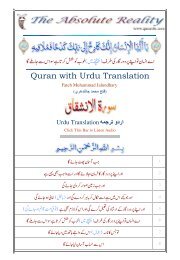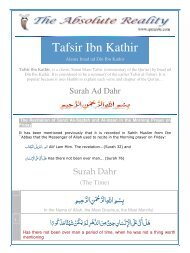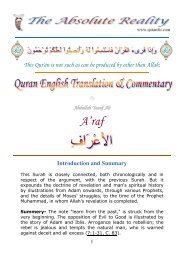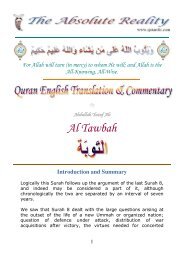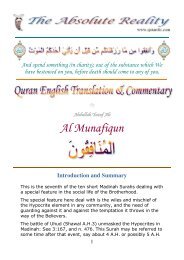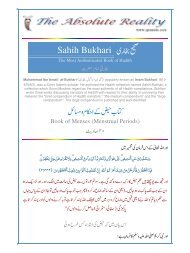Egyptian Religion and its Steps Towards Islam - Quran Arabic ...
Egyptian Religion and its Steps Towards Islam - Quran Arabic ...
Egyptian Religion and its Steps Towards Islam - Quran Arabic ...
You also want an ePaper? Increase the reach of your titles
YUMPU automatically turns print PDFs into web optimized ePapers that Google loves.
Praise be to Allah, the Cherisher <strong>and</strong> Sustainer of the<br />
Worlds;<br />
By<br />
Abdullah Yusuf Ali<br />
Appendix V<br />
<strong>Egyptian</strong> <strong>Religion</strong> <strong>and</strong> <strong>its</strong> <strong>Steps</strong><br />
<strong>Towards</strong> <strong>Islam</strong><br />
(see 7:123, n. 1082)<br />
This should be read alongwith Appendix IV in which a<br />
discussion of <strong>Egyptian</strong> chronology will be found.<br />
Allah's Plan works silently but surely among all nations <strong>and</strong> at<br />
all times. In the most fantastic forms of religion appear gleams<br />
of His Light of Unity, calls to <strong>Islam</strong>, i.e. man’s submission of his<br />
will to the Will of Allah (see C. 7-10).<br />
1
From that point of view, the religious history of Egypt from the<br />
most ancient times to the present day is most interesting, as is<br />
indeed the religious history of any country for which we have<br />
records of thought <strong>and</strong> development. That of India touches us<br />
dearly, but it is not directly relevant in a translation <strong>and</strong><br />
exposition of the <strong>Quran</strong>.<br />
The religious history of Israel is just an earlier chapter of the<br />
history of <strong>Islam</strong>, <strong>and</strong> our doctors <strong>and</strong> commentators have<br />
written in great detail about it. Sometimes, I think, have<br />
attached exaggerated importance to it. But none of them has<br />
paid much attention to Egypt from this point of view. Our<br />
people know very little of ancient Egypt <strong>and</strong> have shown little<br />
interest in it. It is a healthy sign that modern Egypt is showing<br />
much interest in it, <strong>and</strong> I hope that it will in time recognize in it<br />
a valuable unfoldment of religious ideas leading up to <strong>Islam</strong>.<br />
The field of Egyptology is vast <strong>and</strong> is being extended everyday<br />
by the diligent researches of archaeologists <strong>and</strong> scholars. I do<br />
not propose to write an essay on <strong>Egyptian</strong> religion. But I wish to<br />
put forward a few considerations to show how Allah's Plan <strong>and</strong><br />
Will worked steadily, in Egypt as elsewhere, towards a greater<br />
<strong>and</strong> greater appreciation, on the part of the people, of Allah's<br />
true nature <strong>and</strong> the real purpose of religion.<br />
The eternal light of Unity <strong>and</strong> <strong>Islam</strong> shines in many ways, <strong>and</strong><br />
<strong>its</strong> rays give light to the spiritual aspiration of mankind in the<br />
darkest periods. With a gifted <strong>and</strong> artistic people like the<br />
<strong>Egyptian</strong>s, their religious sense was led, in spite of many<br />
rebuffs, gradually to a purer <strong>and</strong> purer conception of man’s<br />
eternal destiny, until Muhammad’s Message was preached to<br />
them in the very language in which it was originally preached in<br />
Arabia. And that language, <strong>Arabic</strong>, became <strong>and</strong> is now the<br />
language of the <strong>Egyptian</strong> people themselves.<br />
In the pre-Dynastic Egypt, there must already have been a<br />
great deal of development in the religious conceptions which<br />
afterwards showed such vitality to Dynastic Egypt.<br />
The Old Kingdom, including the Pyramid Period, shows that the<br />
<strong>Egyptian</strong> mind was obsessed with the certainty of life after<br />
death. It was also impressed with ideas of gr<strong>and</strong>eur, order, <strong>and</strong><br />
precision in the universe-ideas which found eloquent expression<br />
in the gr<strong>and</strong> conceptions <strong>and</strong> mathematical symmetry <strong>and</strong><br />
simplicity of <strong>its</strong> architecture. Its massive dignity <strong>and</strong> repose are<br />
2
also reflected in the faces <strong>and</strong> poses of the figures in <strong>Egyptian</strong><br />
statuary <strong>and</strong> painting.<br />
The unending expanse <strong>and</strong> the mystery of the desert seem to<br />
have acted on the <strong>Egyptian</strong> mind like a soporific <strong>and</strong> made it<br />
less active in mundane affairs <strong>and</strong> less practical in speculation<br />
than that of some other races of similar gifts. What mysteries<br />
are typified in the proportions of the Pyramids <strong>and</strong> their internal<br />
galleries <strong>and</strong> mysterious chambers, we shall probably never<br />
know with certainty. But a haunting sense of death <strong>and</strong> of the<br />
other world seems to oppress us in <strong>its</strong> atmosphere, as it does in<br />
the grim senses of the “Book of the Dead”. As Prof. T.E. Peet<br />
remarks (Cambridge Ancient History, vol I, p. 354),<br />
“the <strong>Egyptian</strong> mind closely associated together men, gods, <strong>and</strong><br />
the dead as merely three species of a single genus.”<br />
Each of these is considered was subject to an irresistible force<br />
called Hike or Heka: hence the force of Magic, Incantations to<br />
the Dead, <strong>and</strong> Rites <strong>and</strong> Formularies in daily life.<br />
The Middle Kingdom brings us face to face with fresh ideas. We<br />
have no data with which to appraise the influence of foreign<br />
cults <strong>and</strong> foreign ideas during the period. But knowing, as we<br />
do, how Egypt acted as a magnet to the world at large <strong>and</strong> how<br />
many points of contact the Euphrates valley civilizations <strong>and</strong> the<br />
Nile valley civilizations had with each other, we may well<br />
suppose a broadening of <strong>Egyptian</strong> culture <strong>and</strong> civilization in<br />
consequence. The Hyksos may have been <strong>Egyptian</strong>ised in<br />
Egypt, but they could not have failed in their turn to contribute<br />
Syrian as Semitic ideas to Egypt.<br />
Among these were Monotheism, a patriarchal organization of<br />
society, <strong>and</strong> an impatience of priestly or caste denomination.<br />
These must have contrasted strangely with the chaotic<br />
Pantheon of countless deities, the lash-driven slaves living<br />
huddled in the cities, <strong>and</strong> the dedicated priests <strong>and</strong> richly<br />
endowed temples, which catered for the privileged few, but<br />
lived by the sweat of the brow of the unprivileged many.<br />
The New Empire was the flowering period of <strong>Egyptian</strong> genius<br />
<strong>and</strong> requires special consideration. The crudities of the old pre-<br />
Dynastic chaotic Pantheon had been in process of attrition<br />
through the centuries. Local gods tended to be absorbed into<br />
general gods. Some sort of rationalism <strong>and</strong> spiritualization had<br />
3
een going on throughout the Dynastic period. A process of<br />
systemization <strong>and</strong> unification was now consciously undertaken.<br />
The primitive worship of animals had gradually been<br />
transformed into a system of animal gods, with human bodies<br />
<strong>and</strong> animal heads.<br />
The human bodies represented the anthropomorphic<br />
tendencies, while the animal heads became types of qualities.<br />
For example,<br />
- Anubis, with the dog emblem, was the doorkeeper, the<br />
messenger, the custodian of the dead.<br />
- Apis, or Hapis, the sacred bull of Memphis, symbolized the<br />
renewal of life, he was identified with Osiris;<br />
there were great rejoicing when a new Apis (a black bull<br />
calf) was found, <strong>and</strong> great mourning <strong>and</strong> costly burial when<br />
one died.<br />
- Thoth, the god of wisdom <strong>and</strong> magic, was symbolized by an<br />
ibis, that stately, mute, mysterious bird of passage in the<br />
Nile valley.<br />
In addition to the symbolism of animals, there was the worship<br />
of the great phenomena of nature, the Nile, the giver of<br />
agricultural bounties to Egypt, <strong>and</strong> the sun, which, as the god<br />
Ra, became the supreme god in Egypt.<br />
Then there was the myth of Osiris the good, who came to the<br />
earth for the benefit of mankind, was killed by the magic of Set,<br />
the power of evil, <strong>and</strong> reign as the judge of the dead in the<br />
lower world. His faithful wife Isis <strong>and</strong> his falcon-eyed son Horus<br />
figure in the mysteries. It is possible that the Osiris myth <strong>its</strong>elf<br />
arose from a myth of the Nile, or the sun.<br />
There was a gradual perception of Monotheism, a realization<br />
that Allah is One <strong>and</strong> above names. But the picturesque forms,<br />
festivals, <strong>and</strong> representations remained, <strong>and</strong> as the priests of all<br />
grades enjoyed special privileges <strong>and</strong> monopolized knowledge<br />
<strong>and</strong> learning, the people remained ignorant. They were<br />
exploited <strong>and</strong> practically enslaved.<br />
It was in the midst of such conditions that Moses came. He<br />
came to rescue his own people from the bondage of Egypt, a<br />
task which he performed. But it must not be forgotten that his<br />
4
mission was also addressed to the king of Egypt, <strong>and</strong> to the<br />
people of Egypt. Here also he sowed the seed, although he did<br />
not reap the fruit. The king, the Pharaoh, was almost looked<br />
upon as a god, <strong>and</strong> looked upon himself as a god. He had to be<br />
humbled, <strong>and</strong> he was humbled.<br />
Bur Allah's purpose is not merely to humble. It is also to lead<br />
from darkness to light. If the particular Pharaoh was too hard<br />
hearted to respond, his descendant in the fifth or sixth<br />
generation made a public confession of the One True God, as<br />
we shall see presently.<br />
What of the people<br />
The wise men of Egypt, who were confronted with Moses,<br />
repented of their deceit, <strong>and</strong> saw the light by the Grace of Allah,<br />
according to the <strong>Quran</strong>ic narrative. Though they were<br />
threatened <strong>and</strong> perhaps martyred, their fate must have opened<br />
the eyes of the people <strong>and</strong> prepared them for the remarkable<br />
religious revolution which we shall now proceed to describe.<br />
The Pharaoh of the Exodus was probably Thothmes I (about<br />
1540 B.C.). the Pharaoh Amenophis IV (about 1350 B.C.)<br />
adopted the worship of the One Supreme God as the State<br />
religion. He had been a high priest of the Sungod at Heliopolis,<br />
but had begun to look upon the multiplicity of gods in the<br />
<strong>Egyptian</strong> Pantheon as a blot on <strong>Egyptian</strong> religion. His original<br />
name had been Ahmen-hotep (“Ammon is satisfied”) as being<br />
devoted to Ammon the great god of the State religion at<br />
Thebes. He changed the name to Akhan-Aton (“Pious to Aton”)<br />
<strong>and</strong> worshipped the Supreme God under the name of Aton. He<br />
ab<strong>and</strong>oned the city of Thebes as being devoted to Ammon <strong>and</strong><br />
founded a new city near the site of what is now Tel al Amarna,<br />
between Thebes <strong>and</strong> Memphis, <strong>and</strong> dedicated it to Aton the<br />
Supreme God.<br />
The clay tablets discovered at Tel al Amarna in 1887 throw<br />
much light on the relations of Egypt with her tributaries in<br />
Syria. The alphabet on the tablets is the Cuneiform of Assyria:<br />
the language is Semitic, <strong>and</strong> closely akin to Hebrew.<br />
unfortunately the religious revolution of Amennophis IV did not<br />
last.<br />
The city was only inhabited twenty years. His second son-in-law<br />
<strong>and</strong> successor, Tutankh Aton, carried out a counter-revolution.<br />
5
He went back from Aton to the cult of Ammon. The recent finds<br />
from his tombs show what exquisite skill the artists <strong>and</strong> artisans<br />
of Egypt had been attained. The pure religion remained<br />
established on the throne only for two generations but we need<br />
not suppose it was rooted out of the minds of the people.<br />
The later Dynasties, XXI to XXXI, saw the decay of Egypt as a<br />
Power. The Assyrian <strong>and</strong> Persian invasions ultimately<br />
extinguished the freedom of Egypt. With the coming of<br />
Alex<strong>and</strong>er the Great (332m B.C.) <strong>and</strong> the foundation of the city<br />
of Alex<strong>and</strong>ria, a new era dawned on the culture of Egypt. It<br />
mingled with Greek <strong>and</strong> other thought, <strong>and</strong> became<br />
cosmopolitan in nature. Already in the time of Herodotus, the<br />
sensitive Greek mind had been impressed with the mystery <strong>and</strong><br />
wisdom of Egypt. It now made the soil of Egypt cosmopolitan in<br />
religion, culture, <strong>and</strong> philosophy.<br />
The Ptolemaic dynasty held a broadly tolerant attitude, <strong>and</strong><br />
even imported the rites of Serapis from the Black Sea <strong>and</strong><br />
assimilated him to Apis the Bull of Memphis. The new cult of<br />
Serapis widely over the East, <strong>and</strong> later, when Egypt came under<br />
the Roman Empire (30 B. C.), into the very heart of the Empire.<br />
The Serapion in Alex<strong>and</strong>ria, with <strong>its</strong> famous library, became for<br />
a few centuries the true intellectual centre of the world.<br />
The very unfavorable picture drawn of <strong>Egyptian</strong> religion in<br />
Lytton’s Last Days of Pompeii must be referred to the somewhat<br />
hybrid cult of Isis as practiced in foreign l<strong>and</strong>s rather than to<br />
<strong>Egyptian</strong> religion generally. What course real <strong>Egyptian</strong> religion<br />
took in this period we have no means of judging accurately. In<br />
the light of earlier <strong>and</strong> later events we may suppose that the<br />
steady honest industrious <strong>Egyptian</strong> peasantry <strong>and</strong> people went<br />
on pursuing the even tenor of their career with the same<br />
mystic longing for a practical religion which was preparing them<br />
for purer forms of worship <strong>and</strong> a juster distribution of the fru<strong>its</strong><br />
of labour.<br />
Alex<strong>and</strong>ria in the first centuries of the Christian era was<br />
resounding with the shouts of every kind of philosophy <strong>and</strong> the<br />
teaching of every kind of religious sect, from East <strong>and</strong> West,<br />
North <strong>and</strong> South, but mainly from the East, which was ever<br />
been a nursery of religious ideas. A special quarter was<br />
assigned to the Jews in the city. It became the true centre of<br />
Hellenised Judaism, <strong>and</strong> may claim Josephus among <strong>its</strong><br />
6
disciples. Neo-Pythagoreanism, Neo-Platonism, Gnosticism, <strong>and</strong><br />
Manichaeism found a home there Mithraism, which was so<br />
widely spread in the Roman Empire, especially in the army, in<br />
the first three centuries A.C., was probably represented on <strong>its</strong><br />
philosophic side in Alex<strong>and</strong>ria. Its intermixture of races, creeds,<br />
philosophies, <strong>and</strong> religions, produced an atmosphere of chaos,<br />
which was not cleared until the advent of <strong>Islam</strong>.<br />
But from a religious point of view our greatest interest in Egypt<br />
in the first seven centuries of the Christian era is in the<br />
development of Christianity <strong>its</strong>elf. It is difficult to say even when<br />
exactly Christianity began to displace the older <strong>Egyptian</strong> cults.<br />
But when Christianity was well-established, we find Egypt one of<br />
<strong>its</strong> most important centres. But the new Christianity which was<br />
evolved out of the ruins of the Christ’s simple teaching had four<br />
distinct attitudes towards organization, speculative doctrine,<br />
asceticism <strong>and</strong> mysticism.<br />
1. The native <strong>Egyptian</strong>s or Coptic Church was contemplative,<br />
ascetic, <strong>and</strong> mystical. Monasticism became so rampant that<br />
it seriously affected the growth of population <strong>and</strong> degraded<br />
the position of women.<br />
2. The Alex<strong>and</strong>rian school developed on Greek lines-political,<br />
ambitious, speculative, philosophical, <strong>and</strong> liable to break up<br />
into numerous sects <strong>and</strong> heresies, each party trying to<br />
dominate <strong>and</strong> put down the others as heretical by the<br />
strong arm of the law.<br />
3. The Bishop of Rome, when the seat of the Empire was<br />
transferred to Constantinople in 330, gradually developed<br />
political power in Italy. He inherited the Roman genius for<br />
organization, <strong>and</strong> the invasion of the Germanic tribes gave<br />
him an opportunity not only of extending the Roman<br />
Catholic Church over the whole of Central <strong>and</strong> Western<br />
Europe, but of establishing the Church as superior to the<br />
state when the Papacy became an established political<br />
power.<br />
4. The Orthodox Eastern Church , <strong>and</strong> all the sects which it<br />
fought in the East, tended ultimately to vanish before the<br />
advance of <strong>Islam</strong>. Had it not been for the vast Slav<br />
territories over which it obtained sway, in <strong>and</strong> around<br />
Russia <strong>and</strong> afterwards in Siberia, the Orthodox Eastern<br />
7
Church would have been reduced to a negligible position<br />
like the Coptic Church in Egypt. With pretensions to rule the<br />
State, it had yet become, in Kingley’s words in Hypatia, the<br />
“stipendiary slave-official” of the Empire.<br />
But we are anticipating. Before the Roman Catholic Church<br />
parted from the Orthodox Eastern Church, the united Church<br />
fought with <strong>and</strong> suppressed many so-called “heresies”, some of<br />
which represented the view of primitive Christianity, <strong>and</strong> the<br />
scene of many of these doctrinal fights was in Egypt.<br />
The one that interests us most is Aryanism. Arius was an<br />
Alex<strong>and</strong>rian Presbyter early in the fourth century A.C. <strong>and</strong><br />
fought hard for the doctrine of Unity, the simple conception of<br />
the Eternal God, as against all the hair splitting <strong>and</strong> irrational<br />
distinctions in the nature <strong>and</strong> persons of the Godhead, which<br />
finally crystallized in the doctrine of the Trinity, propounded <strong>and</strong><br />
maintained with much personal acrimony by Athanasius.<br />
Athanasius himself was born in Alex<strong>and</strong>ria <strong>and</strong> became Bishop<br />
of Alex<strong>and</strong>ria. He may be counted as the father of Orthodoxy<br />
(as now understood by Christianity) <strong>and</strong> the real systematiser of<br />
the doctrine of the Trinity-“three in one <strong>and</strong> one in three.” Up to<br />
the third century A.C. the Unitarians had been in the majority in<br />
the Christian Church, though subtle metaphysicians had started<br />
dispute as to the meanings of “God becoming man.” The Logos<br />
or the Word, the Power of Allah, whether the Father <strong>and</strong> the<br />
Son were of the same substance or of similar substance,<br />
whether the Son could be said to have been created by the<br />
Father, <strong>and</strong> numerous questions of that kind. They do not<br />
interest us now, but they rent the Christians world into many<br />
jarring sects until the mission of our Holy Prophet dissipated the<br />
mists <strong>and</strong> reestablished the doctrine of Unity on a firm <strong>and</strong><br />
rational basis.<br />
As I have said, the Christian Churches in the East, as well as the<br />
Germanic nations which came later into the fold, adhered to<br />
Unity although not in the pure form which was made clear in the<br />
Holy <strong>Quran</strong>. The issue was joined between Arius <strong>and</strong><br />
Athanasius, <strong>and</strong> the first General Council on the Christian<br />
Church, that of Nicaea (in Bithynia) in 325, decided against<br />
Arius <strong>and</strong> Unitarianism.<br />
8
The controversy, however, still continued to rage until 381,<br />
when the Council of Constantinople, called by the Emperor<br />
Theodosius the Great, confirmed the Nicene doctrine of the<br />
Trinity <strong>and</strong> declared it to be the only Orthodox one. Though<br />
controversies, protests, <strong>and</strong> persecutions continued long<br />
afterwards, we may take that date as the date of the fall of<br />
Christianity. Even in Western Christianity, as late as 496, Clovis,<br />
the Frankish king, was the only Christian sovereign<br />
sophisticated enough to follow the subtle doctrine of the Trinity.<br />
The others were brought into line by political power later.<br />
The Christian creed became narrower <strong>and</strong> narrower, less <strong>and</strong><br />
less rational, more <strong>and</strong> more inclined in use earthly weapons to<br />
suppress the eternal truth of Allah.<br />
In 415 the Jews were expelled from Alex<strong>and</strong>ria. In the same<br />
year <strong>and</strong> in the same city the beautiful, modest, eloquent<br />
philosopher <strong>and</strong> mathematicians, Hypatia, was murdered-an<br />
outrage against both rationalism <strong>and</strong> the intellectual <strong>and</strong><br />
religious position of woman in human society. The murder was a<br />
particularly brutal one. She was dragged from her chariot in the<br />
streets, stripped naked, <strong>and</strong> suffered a lingering death in a<br />
Christian Church. Her body was then cut to pieces <strong>and</strong> burned.<br />
The worst features of the crime was the complicity of the<br />
Patriarch of Alex<strong>and</strong>er, who was not only the chief religious<br />
dignitary of the Orthodox Church in Egypt but the de facto<br />
repository of political power. Meanwhile the native Christian<br />
community-the Coptic Church-which had all along clung to the<br />
Monophysite doctrine, a corrupt form of Unitarianism, was out<br />
of the pale, <strong>and</strong> <strong>its</strong> members were held down as a depressed<br />
class by their Orthodox brethren. The latter also, basking in<br />
official sunshine, collected power <strong>and</strong> property into their own<br />
h<strong>and</strong>s. As Kingsley remarks in Hypatia, the <strong>Egyptian</strong> Church<br />
“ended as mere or false, were equally heretical in their mouths<br />
because they used them as watchwords for division.”<br />
The social conditions produced an amount of discontent, for<br />
which the redress came only with the advent of <strong>Islam</strong>.<br />
It was for this reason that the Copts <strong>and</strong> the inhabitants of<br />
Egypt generally welcomed the forces of <strong>Islam</strong> under ‘Amr as<br />
deliverers in 639 A.C. the power was taken over by the<br />
victorious army of <strong>Islam</strong> from Cyrus (called Muqawqas in <strong>Arabic</strong><br />
9
through the Coptic), the Patriarch of Alex<strong>and</strong>ria, but it was used<br />
by the army of deliverance to enlarge the liberties of the<br />
<strong>Egyptian</strong>s, to admit them into the universal brotherhood of<br />
<strong>Islam</strong>, <strong>and</strong> to improve the resources of the country for the<br />
benefit of the people. Except a negligible remnant of<br />
conservatives, the <strong>Egyptian</strong>s as a nation accepted the religion,<br />
the language, <strong>and</strong> the institutions of the Arabs <strong>and</strong> embarked<br />
on a new course of history, which it is necessary to follow<br />
further in this note.<br />
It should be remarked, however, that what happened in Egypt<br />
happened generally in western Asia. The jarring sectarian<br />
irrational religious gave place before the triumphant religion of<br />
Unity <strong>and</strong> Brotherhood, <strong>and</strong> the Byzantine Empire receded <strong>and</strong><br />
receded until it was swept out of existence. The feeble efforts<br />
made by the Emperor Leo the Isaurian in 726-731 to restrict<br />
the use of images were a reflection of the puritanical zeal of<br />
<strong>Islam</strong>. But they did not succeed in the area of his authority, <strong>and</strong><br />
they completely alienated the Papacy from the Eastern<br />
Orthodox Church.<br />
The Bishop of Rome had been consolidating his power, <strong>and</strong> in<br />
the person of Gregory I (590-604) had already assumed the<br />
control of Italy <strong>and</strong> was seeking the aid <strong>and</strong> support of the<br />
Barbarian invaders who eventually became the pillars of the<br />
Papacy.<br />
The final <strong>and</strong> open rupture between the Orthodox Eastern<br />
Church <strong>and</strong> the Roman Catholic Church took place in 1054. but<br />
the earlier dates are remarkable. After the birth of the Holy<br />
Prophet of <strong>Islam</strong> the disruption of the Orthodox Christian<br />
Church (which had now become an anachronism) began.<br />
When <strong>Islam</strong> was making <strong>its</strong> triumphant march in the 8 th century<br />
after Christ, the original (Greek) Church began to take some<br />
steps to puts <strong>its</strong> own house in order. But it had lost <strong>its</strong> mission,<br />
<strong>and</strong> the new <strong>Islam</strong>ic people took <strong>its</strong> place. The Western Church<br />
has since worked on definitely new lines, <strong>and</strong> <strong>its</strong> offshoots<br />
among the Protestant Church have consciously or<br />
unconsciously, been influenced by the broad principles of <strong>Islam</strong>.<br />
What the course of future religion may be <strong>and</strong> how Allah will<br />
unfold His All-Wise Plan is not given to us mortals to know.<br />
10
In the <strong>Islam</strong>ic Brotherhood many changes have taken place <strong>and</strong><br />
are taking place. Egypt, in spite of her many vicissitudes in the<br />
<strong>Islam</strong>ic period, is in the intellectual forefront among the <strong>Arabic</strong>speaking<br />
nations of <strong>Islam</strong>. We pray that her people may be<br />
guided, through their educational, cultural, <strong>and</strong> religious<br />
channels, to work with a new spirit for the progress of <strong>Islam</strong><br />
<strong>and</strong> the glory of Allah.<br />
References:<br />
Those given for Appendix IV: <strong>and</strong> in addition:<br />
Sir E.A. Wallis Budge. Gods of the <strong>Egyptian</strong>s: <strong>and</strong> his latest book From Fetish to God<br />
in Ancient Egypt (Oxford 1940:<br />
Budge. Book of Dead; A.W. Shorter, Introduction to <strong>Egyptian</strong> <strong>Religion</strong> (1931);<br />
Adolf von Harnack, History of Dogma, 7 vols., is an elaborate detailed German<br />
account of how Christian Dogma grew up <strong>and</strong> may be read in an English translation;<br />
a h<strong>and</strong>ier book is R.W. Mackay, Rise <strong>and</strong> Progress of Christianity (1854);<br />
C. Kingsley’s novel Hypatia gives a good picture of social <strong>and</strong> religious conditions in<br />
Christian Egypt in the fifth century. On the identity of al Muqawqas (Pkauchios) with<br />
Cyrus,<br />
see Dr. A.J. Butler’s “Arab Conquest of Egypt.” (Oxford 1902), pp. 508-562.<br />
© Copy Rights:<br />
Zahid Javed Rana, Abid Javed Rana<br />
Lahore, Pakistan<br />
www.quran4u.com<br />
11



